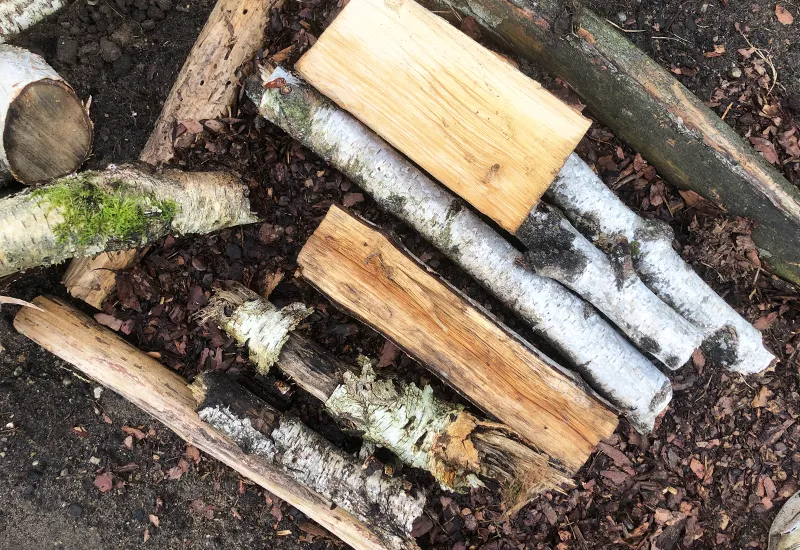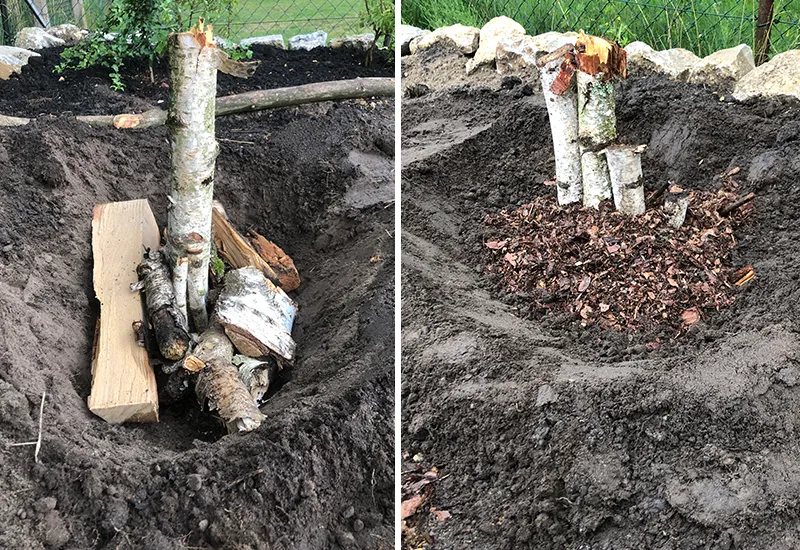Do you want to create a bug cellar and help the small insects in your garden? Then you've come to the right place! Whether cockchafer, ladybug, fire beetle, stag beetle or "firefly" - there are around 7,000 incredibly fascinating species of beetle in Germany, which act as scavengers in nature and are a fundamentally important source of food for many animals.
Unfortunately, their natural habitat is increasingly disappearing - mainly because many people have created "perfect" or absolutely low-maintenance gardens with few plants and structures.
Fortunately, you can provide shelter for the beetle world and attract beneficial insects to your garden with a simple measure: we are talking about building a beetle cellar, also known as a beetle castle or beetle larva castle.
In this article, I would like to show you how to build an effective bug cellar. From the advantages to the material, the right location and the necessary work steps, you'll now find out everything you need to know. Let's go!
Here you can find a short overview in advance:
Reasons: What are the advantages of a beetle cellar?
A beetle cellar is Inexpensive and built in 2-5 hours, more than low-maintenance and also needs only little space. But of course it has even more profound advantages that should motivate you to do this DIY project in the garden! Here I present the most important motifs:
- Promote biodiversity: With a beetle cellar, you create a valuable habitat for many small native animals and counteract insect mortality. You also offer them protection all year round - even in winter.
- Support beneficial organisms: Beetles eat "pests", such as aphids or snails. The animals attracted by the beetle cellar therefore act as natural pest controllers.
- Improve soilBeetles decompose organic material. The more of them there are in your garden, the better it is for the soil quality and the growth of your plants.
- Promoting environmental knowledgeA beetle cellar also fulfills an educational function and is a great measure of Environmental Education. Building together can teach children in particular, but also adults, the importance of Biodiversity and the role of insects in our natural world.
Material: What do I need for a real beetle castle?

As I said, it doesn't take much! The most important material for a beetle cellar is Deadwood - especially smaller logs, branches and twigs. Just ask the foresters in your region or use plant cuttings from your own garden. Natural garden.
It is best to place the wood in different degrees of rotting so that not everything rots at the same time. You should also pay attention to Different types of wood as every beetle has different requirements and you want to support as many species as possible.
In addition, some Leaves, sawdust, bark mulch, compost, straw, plant cuttings and definitely a few Fieldstones helpful so that the "insect party at the castle" can go ahead. But it doesn't matter if you don't use all of it, the party will still go ahead 🙂
Location: Where is the ideal location for an effective beetle cellar?
If you want to create a beetle cellar, it is essential to ask yourself the question of location in advance! Most beetles in Germany prefer a wind-protected, not soaked but humid environment, which they can use naturally. in shady or semi-shady areas and not in direct sunlight.
To ensure that your Käferkeller is well received, you could, for example, choose a place under or on a deciduous tree which provides shade for most of the day.
Also make sure that the location for the animals is Easily accessible is and Plants with pollen-rich flowers nearby are. These can be wild roses, fruit trees or angelica, yarrow and wild carrot, for example.1
Work steps: How do I build a beetle cellar?

Advantages, material, location - now you already know quite a lot about the beetle cellar and the needs of the little insects! But what's missing? One Step-by-step instructions!
Even if they really simple and short I would of course like to give it to you at this point.
After the Location determined you can simply proceed as follows when building the beetle castle:
1. dig a hole
If you want to build a beetle castle, the hole should be at least 70×70 centimeters wide and about 40-60 centimeters deep be. In addition, beveled and flat not too steep walls important so that the beetles can crawl in and out without stress.
2. insert wood
A combination of larger pieces of fresh and rotten hardwood (e.g. birch and oak) and also some softwood is ideal.
Place some wood uprightso that you can later recognize the degree of rotting from the outside to some extent. The shorter the timbers are, the more has already been "worked off". It also really looks like a small castle now 😉.
3. add further biomass
Now you can add natural material. I have opted for small branches and twigs, compost, bark mulch and some leaves decided. Also a few Fieldstones I built in the insect-friendly beetle cellar to create a few gaps here and there.
4. build up the surface layer
Now the core of the beetle castle is ready. Around it and the little animals protect from windyou can now form a small, bordering hill. Simply use the Excavated earth.
5. cover the beetle cellar
With a little Bark mulch or straw you can now give the beetle cellar a kind of roof, so that the inside is a beetle-friendly place. Microclimate forms. That is all!
After that, it's time to wait and watch the beetles go about their business in your wild corner in garden and in the course of time Add some wood from time to time. 🙂
FAQ: What are the most frequently asked questions about the Käferkeller building?
You now know how to create a bug cellar. However, you may still be missing a few important tips at this point - or have general questions on the tip of your tongue.
In fact, there are some very typical questions about the Käferkeller. Finally, I will provide you with the relevant answers here:
Which wood is ideal for the beetle cellar?
Basically, any untreated, natural wood from native deciduous trees or conifers is suitable for a beetle cellar. Ideal types of wood are above all Oak, beech, birch and also fruit trees.
However, you should avoid treated or varnished wood, as this may contain harmful chemicals. The more natural your bug cellar is, the better.
How deep does a beetle cellar have to be?
If you want to create a beetle cellar, you should dig a hole with a depth of approx. 40-60 centimeters excavate. This is generally sufficient to provide the beetles and other insects with sufficient protection and shelter.
Which insects benefit from a beetle cellar?
An incredible number of beetles benefit from a beetle cellar. Depending on the material and environment, you can, for example Ground beetles, fireflies, ladybugs, Stag beetles or also Rhinoceros beetles do us a favor.
How do I maintain a beetle cellar?
Once completed, a beetle cellar only needs your attention once, when the material runs out at some point. If necessary, you can then simply add some new deadwood and foliage.
Creating a bug cellar: as easy said as done!

A beetle cellar is a wonderful DIY project with which you can actively make an important contribution to the Protecting biodiversity and give the beetles a valuable habitat in your near-natural garden to the garden. You will also benefit, as the soil quality will improve and you will naturally get rid of so-called pests in the garden.
"Any stupid boy can crush a beetle. But all the professors in the world can't make one."
Arthur Schopenhauer (more at Environmental protection quotes)
I hope this article has inspired you to take action yourself, help the bugs and turn your garden into a blooming paradise for the largest order of the insect class.
Do you have any questions or would you like to share your own tips and experiences? Then I look forward to your comment!
Stay close to nature and open to new things,

PS: Do you want to help insects in your garden? Then be sure to take a look at my articles on the Building a cairn biotope and with the Tips for a bee-friendly garden on. Have fun with the implementation!
References:
- NABU (Nature and Biodiversity Conservation Union) e. V.: Which insect goes with which plant?, available at https://www.nabu.de/umwelt-und-ressourcen/oekologisch-leben/balkon-und-garten/tiere/insekten/26768.html. [01.07.2024]. ↩︎




